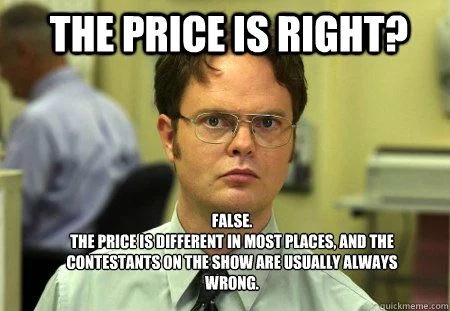Do you remember the game show where contestants had to guess how much something costs? Yes, of course, it’s The Price is Right!
As an experience provider, your life might be as entertaining as a game show — especially when it comes to tour costing and pricing. And as you probably know, your prices need to cover your costs — all of them.
Learning how to price a tour package is no small feat. Sure, being fully booked is wonderful, but your goal is to be profitable. And, if you can create a sustainable pricing structure early on, you’ll be resilient in the long term.
In this post, you’ll learn what goes into tour costing and pricing and learn how to re-evaluate pricing at the end of each busy season.
What goes into tour costing and pricing
Pricing impacts how guests feel about the experience they’re buying. If a booking is priced too low, it may seem cheap. On the other hand, if an experience is priced too high – it might be out of budget for your target market.
Most people, consider themselves to be somewhere in the middle when looking at pricing. Meaning if guests are presented with 3-4 options, they’ll gravitate towards the middle-range tour package options.
When setting your pricing, you’ll want to account for operating costs as well as profitability. Doing so will nudge you further towards setting prices that align with the goals of your tour business. And while pricing itself may not be complicated, it is an art.

You wouldn’t be alone if you’ve made the error of evaluating your tour business competition and setting prices just below or slightly above in order to attract bookings.
And while we can understand wanting to increase your share of the market, you should base your pricing on insights from your unique tour business.
When pricing a tour package, consider these questions:
- What type of activity or tour are you producing/selling?
- How many people can you accommodate?
- How many tours will you be running per day?
- What operating expenses do you have?
- How many of your costs are fixed vs. variable?
- Are you a seasonal business that experiences high demand at certain times of the year?

Guests want you to tell them why a tour is worth the price you’ve set. Be sure to note duration, add-ons and whether transportation is included in the total price. Ultimately, you want your brilliant tour description to back up the price and make it easy for guests to say, “that sounds like it’s worth it.”
Looking for a better way to price your tours?
How to price a tour package
One method of tour costing and pricing involves a cost-plus pricing strategy where you input all of your expenses and anticipated revenue. From there, you’ll add in profit and revenue targets.
When pricing tours and activities, you’ll usually hear something about setting objectives or knowing your bottom line. Here are some expenses to account for when establishing the costs of running a tour business:
Example fixed costs for your tour business
- Administrative costs (2-5%)
- Booking software (5-10%)
- Business Insurance (10-20%)
- Employee wages (20-25%)
- Equipment depreciation (10-30%)
- Leasing and/or rental costs (20-30%)
- Phone and Internet bills (2-5%)
- Utilities (5-10%)
Sample variable costs
- Accommodations
- Meals
- Transportation
- Gas and maintenance costs (5-10%)
- Hourly guide wages (depends)
- OTA commissions (10-30% of the booking price)
When pricing a tour, you’ll want to know your capacity and overall operating costs. Once you know your baseline expenses, you can use this information to develop a sense of your target profit margins.

Methods for setting the price of a tour
Using a method known as cost-plus pricing, you’ll combine all of your anticipated expenses and add a profit on top. The basic principles of pricing a tour package account for:
- fixed costs
- variable costs
- a markup or profit margin.
You will calculate costs + expenses + profit + commission structure (which is usually a percentage based on the tour price including the total number of guests).
Ask yourself these questions to address when pricing a tour:
- What are your costs per person?
- If you were to book as a group, ie 4+ people, how much can you charge per person?
- Let’s say you price the time slot as a fixed amount and add an additional fee per person on top of the minimum guest count
- You can also set a price for a private tour booking, regardless of the number of guests
Alter your profit margin depending on the season and number of guests. Let’s say you need 4 guests to break even. And if you have 6 guests who book, the additional two people then make the tour profitable.
This way your time is always being compensated and you’re not burning out by running tours that aren’t paying for themselves. As Peter Syme says in his interview with Tourpreneur “many tourism business owners are guilty of underestimating their costs and undercharging as a result.”
Packaged tours typically follow a structure with a designated amount of time for each activity. Some tour companies present lower prices designed to get potential customers in the door. For instance, even if a single booking may not be profitable, this strategy may generate enough volume to make it worthwhile.
Sure, competing on price alone can be tough, especially if you’re offering the same activity or a similar type of tour. When pricing a tour package, forecast, plug in the numbers of how many bookings you need to break even and turn a profit so you know what you’re working with.

1. Tour type
Perhaps you’re in the business of food or walking tours where all your guests have to do is show up and be entertained. On the other hand, you might be a kayaking guide or provide guests with bicycle rentals. Consider whether you have additional costs as a result of the tour type you offer.
Looking at your local competitors, similar companies and OTA’s will help you get a sense of market rates.
Sure, it’s helpful to get a benchmark when looking at tour prices — but don’t let this define your pricing objectives. Ultimately, your approach to tour costing and pricing needs to cover costs and establish a profit margin — even if it’s only 10-15% after your costs are accounted for.
2. Demand
If you’re already in your busy season, you might find yourself stretched thin with what you can do independent of additional staff.
If you operate multiple tours daily, do you need to keep staff on hand to run additional tours?
For instance, is there a busy season or peak booking times when you offer a waitlist for guests?
Are planning to offer group tours or sticking to private tours? This decision factors into how much you can charge per booking.
Guests should be able to tell what is included in the tour price with ease. An added perk of private tours is in alleviating concerns about not meeting minimum guest requirements. This means you can run tours with fewer people and still be profitable.
Thankfully, the benefits are there for both guests and tour businesses alike. For guests exploring whether to book a private tour, the expectation is that they’ll pay more in exchange for a higher-quality experience.
3. Duration
Are you taking guests on 1-2 hour tours or multi-day expeditions? The duration and frequency of your tours will be dependent on how the amount of staff you have available.
Longer tours have the potential of increased profits if account for all fixed and variable costs. Multi-day tours need to account for greater fixed expenses and increased booking logistics as well.
4. Upselling
When creating travel packages, consider what your guests want and whether they’ll pay more if you make their travel plans even easier. Perhaps you can increase your tour price by adding in a meal or transportation option as part of specific tours.
As you look to create added value travel, you’ll see more guests share and rave about you on review platforms. One way to look at this is to view every booking as an opportunity to provide guests with more value than they’ve paid for, especially if the activity the experience is a once-in-a-lifetime opportunity.
5. Seasonality
Do you find yourself with an insane summer season or is the wintertime busy with bookings? Depending on your tour business model, certain expenses, like staff wages can significantly increase your costs depending on the season.
As part of your seasonal marketing strategy, you’ll find a different approach might work better. One option might be to offer early bird pricing deals in the Winter ahead of the Spring season.
Your tiered pricing strategy might be encouraging smaller groups to book together. With different tactics that speak to your customer’s needs, you can incentivize guests to book and stay longer depending on your pricing objectives.
Sure, seasonality may mean dramatic fluctuations in your pricing. And while the tipping point might be 20-30% lower than what you could charge for the same experience in your busy months.
At the end of every busy season, aim to dedicate one day to reviewing reports from the last 3-6 month’s worth of bookings. This will let you see if you’re turning a profit, if your costs are creeping up and whether there are opportunities to boost prices for improved margins.
6. Operating expenses
Administrative, rental and staff wages can play a massive role in your tour business margins. At the same time, it pays to know your overall operating expenses, one of the benefits of a booking system subscription model is knowing some of your costs every month.
This way, you can account for costs and estimated bookings or your sales forecast when pricing your tour. Plus, once you determine your break-even point, you’ll have more knowledge available to help you decide how to price a tour package.

Why profit isn’t a dirty word
Building profit into your tour costing and pricing means you’re creating a contingency plan ahead of slower booking periods. And depending on whether you accept a booking deposit (usually anywhere from 25-50% of the tour price) or require full payment in order to reserve a booking, booking payment(s) may be spread out.
Let’s say you have funds flowing out of the business for overhead or wages for your tour guides, you need to be able to recoup the cost of doing business with your tour prices.
Cash flow is essential when you’re building and scaling a tour business. And why it’s in your best interests to build in profit from the beginning.
Profit margins might look like anywhere from 10-40% of your posted tour price, depending on your specific business model along with the season. Sure, businesses are designed to make money. The added benefit of running a profitable business is that it gives the power to determine when and how fast you scale.
Remember, you’re in the business of providing memorable experiences for your guests. If you’re committed to being it for the long haul, tour costing and pricing needs to reflect your hard work. In order to serve future customers, by strategically pricing your tours, rentals and activities, you’re setting your business to run sustainably, over the long term.

What goes into pricing private tours
Given how the pandemic impacted group tours in many parts of the world, private tours have grown in popularity. In addition, your capacity for multiple tours will be limited if you focus on private tours, which explains why pricing for these types of tours is typically higher.
Sure, you might not have to pay as much in staff wages, as part of your variable costs, but you still need to account for fixed costs with your tour pricing.
In addition, some guests are willing to pay more for the convenience of having a guide all to themselves. And according to this Tourpreneur article on pricing private tours, you need to distinguish how private tours differ in value when compared to group pricing in marketing efforts.
Let’s say you have a couple who prefers to tour at their own pace. Perhaps they find group tours exhausting or they would rather have the flexibility to explore hidden gems at a different pace or time. If niching into private tours, account for the limation placed on you without being able to charge more for each individual person who joins the tour. So, where does this leave you?
You need to charge accordingly for your time. Is it more expensive for the two people booking a private tour? Yes — most likely.
Since private tours are considered more of a luxury offering, private tour packages typically yield a higher price point. For guests, a one-on-one experience offers increased value through flexibility and personalization.
How to increase margins and reduce expenses
Every tour business has to account for fixed and variable costs which can fluctuate between the seasons. With inflation and operating costs rising each year, it’s worth reviewing pricing on a yearly or even seasonal basis. Savvy tour operators account for a marketing budget (consider this money you get to spend targeting your ideal guests and have fun with it).
Explore marketing distribution by exploring different channels, like OTAs as needed to help increase bookings as it makes sense for your business.
As distribution channels that can get you more bookings, OTAs typically take a commission of anywhere from 15-30% of your booking fee. As a result, setting aside some revenue earmarked for business promotion can increase direct bookings which allows you to keep more in your pocket.
Your bottom line refers to the amount remaining on a balance sheet displaying a company’s financials. Another term for this is net profit, or what’s leftover after commissions, expenses and salaries are factored in.
Most importantly, this is where seeing where your revenue meets your expenses, so you can charge enough to cover costs and still come out ahead.
As an added bonus, looking at your sales forecast can also help you in determining what type of booking software to invest in. Generally, you’ll have the option of either a fixed monthly subscription or a commission fee. Other reservation technology providers take a percentage of bookings with fees running anywhere from 5-6% depending on the provider you choose.
Final thoughts
Tour pricing is worth revisiting before diving into and after every busy season. In your slower times, you can evaluate data from previous bookings. With this insight, you can create even better, and more profitable, packages going forward.
Always look at what gets guests in the door. Is it your superior service? Is it your consistency and reliability? Are you a master at personalizing private tours or is your seasonal pricing strategy right on the money?
People are much more inclined to buy from companies they know and trust. Feel free to look at upselling opportunities to increase revenue and provide added value for your guests.
Look ahead and set some goals for where you want to be. Continue to lean into your pricing strategy so you have solid momentum to build and scale your business to meet the pent-up demand for remarkable travel experiences.
Want to take Checkfront for a spin?

Take your business to the next level
Online bookings. Flexible pricing. Outstanding support.



